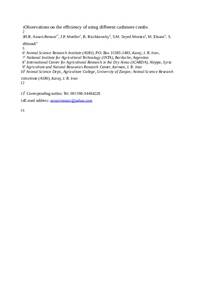Observations on the efficiency of using different cashmere combs

Authors:
tThe effect of using small or large cashmere combs on cashmere harvest, cashmere qualityand combing time was studied on Raeini cashmere goats in nomadic goat breeding systemsof the Iranian province of Kerman. Two groups of 20 goats of different ages were combedwith either a large or a small comb, three times with intervals of 2 weeks in early springwhen natural fiber shedding has started. Combed cashmere weight, duration of combing,fiber diameter, and down yield were measured. A sample of combed cashmere was ana-lyzed using a Laserscan instrument. A general linear model including type of comb, stageof combing and age of goat was fitted to analyze the data. Small combs collect more cash-mere (31.0 vs. 21.7 g, P < 0.01) than large combs without affecting down yield or down fiberdiameter (P > 0.05) but combing time is higher (3.75 vs. 2.79 min, P < 0.01). In the first twocombing sessions much more cashmere was obtained than in the last (28.1, 32.0 and 19.0 g,respectively, P < 0.01), but the weight of total combed cashmere was much less than typicalshorn fleece weights. Combing can be justified only if a considerable price premium can beobtained from selling combed cashmere instead of selling shorn cashmere, or if the combedcashmere is used to add value on-farm. If this is the case, small combs with short rods arepreferable since more cashmere can be collected without affecting its quality.
